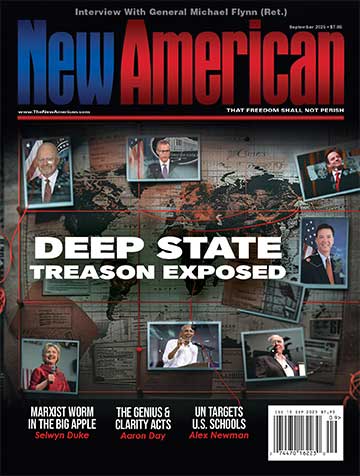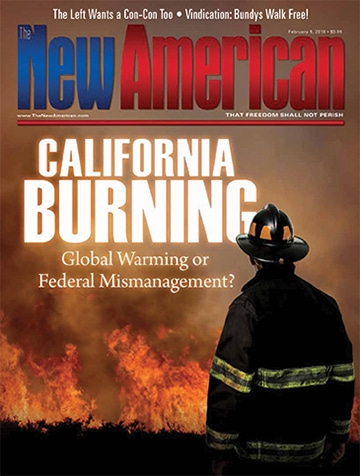California Burning: Global Warming or Federal Mismanagement?
“You never want a serious crisis to go to waste,” former Obama chief of staff and current Chicago mayor Rahm Emanuel once famously said. In other words, when something horrific happens, make sure to use it to further your own political agenda. The recent California wildfires are one such crisis that climate alarmists have pounced upon in order to moan about the hypothetical menace of anthropogenic global warming. Unfortunately for the doomsayers, science and facts simply do not line up with their claims.
California Governor Jerry Brown has been very vocal in blaming the intensity of California’s recent wildfires on anthropogenic (man-made) global warming. Brown has called the extremely large fires of this year “a new normal.” The governor didn’t mince words when he claimed, “With climate change, some scientists are saying Southern California is literally burning up.”
And Governor Brown is not alone. Columbia University climate scientist A. Park Williams said of the 2017 California wildfires, “This is looking like the type of year that might occur more often in the future.” UCLA climate scientist Daniel Swain says, “There’s a clear climate signal in these fires because of the drought conditions connected to climate change.” Even former President Barack Obama linked more severe wildfires to climate change in a 2014 interview with NBC’s Al Roker: “This is a problem that is affecting Americans right now. Whether it means increased flooding, greater vulnerability to drought, more severe wildfires — all these things are having an impact on Americans as we speak.”
But despite those pronouncements, the actual science on whether or not man-made global warming is intensifying wildfires in California and elsewhere is far from settled. In fact, those claims are in a great deal of doubt.
In Wales, a 2016 study by Swansea University professors Stefan H. Doerr and Cristina Santin, published by the U.K.’s Royal Society, concluded that “the widely held perception of increasing fire and fire impacts at the global and some regional scales is not well supported by the realities that the available data show.” The authors further deduced that “there is less overall fire in the landscape today than there has been centuries ago.”
In 2013, Dr. Bjørn Lomborg of the Copenhagen Consensus Center declared, “Historical analysis of wildfires around the world shows that since 1950 their numbers have decreased globally by 15%.” Lomborg also tweeted in October of this year, “Forest fires in California and elsewhere devastating. But nowhere near record. About 1/5 of US Wildfire record.”
Back in America, Dr. David B. South, professor of forestry and wildlife sciences at Auburn University, recently told the Senate Environment and Public Works Committee, “To attribute this human caused increase in fire risk to carbon dioxide emissions is simply unscientific.” The federal government’s own data show that the number and scale of wildfires has decreased dramatically since the 1930s. Wildfires in the United States destroyed more than 50 million acres in 1930. In 2017, approximately nine million acres have been destroyed.
“These data suggest that extremely large mega-fires were four times more common before 1940,” South said. “We cannot reasonably say that anthropogenic global warming causes extremely large wildfires.”
But there’s no doubt that, in recent years, the wildfires in California and other Western states have become more intense and more destructive. Why is that? There are many factors, both natural and man-made, that have contributed to the intensity of the wildfires in California.
Mother Nature’s Role
California’s climate always has been and always will be ripe for wildfires. Most of the state has what is known as a Mediterranean Climate. Wet winters become dry summers as the jet stream moves north. This has always been so. Areas in California at risk for wildfires will almost always be dry by the end of summer when wildfire season begins because summer months are always dry.
All fires require fuel and an ignition source. The Santa Ana and Diablo winds that California experiences increase both of these things. The Santa Anas, in particular, are extremely dry and hot downslope winds that occur yearly in California, most typically in the autumn. The Santa Anas usually peak in September or October. The winds first dry out the vegetation, which creates kindling for the infernos. The heavy gusts, sometimes up to 80 mph, then blow trees and power lines down, creating the sparks needed for ignition.
Another natural factor is that the Pacific Ocean is currently in a weak La Niña phase. This phenomenon, as opposed to its sibling phase El Niño, creates a generally cooler environment in the Pacific. La Niña seems to be caused by a build-up of cooler-than-normal waters in the Pacific Ocean between the Tropics of Cancer and Capricorn — not global warming. Upwelling brings this cooler water to the surface, which drops the temperature of the surface water, thus affecting the climate.
La Niña disrupts weather patterns and makes it difficult for late autumn storms to make landfall in California. The entire southern tier of America typically sees far less precipitation during times of La Niña. It is speculated that a long period of La Niña caused the dust-bowl conditions in 1930s America. Precipitation, stalled by La Niña, could have stopped the large Southern California fires far more quickly.
Referencing the Thomas Fire in Ventura County, Governor Brown claimed, “The fires are changing.… The way this fire performed, it’s not the way it usually has been. Going in lots of directions, moving fast, even without the hot winds.”
The phenomenon the governor is referencing — with the fire moving in different directions and seemingly creating its own winds — is commonly known as the Peshtigo Paradigm, so named for an 1871 wildfire in Northern Wisconsin that killed over 1,200 people. The Allied militaries studied the effects of the Peshtigo Fire in order to recreate them over Dresden and Tokyo in World War II. The paradigm posits that any large fire with a large supply of fuel will basically create its own wind conditions. So the California fires are not acting differently at all. Fire is simply acting the way it always acts.
There is even data that suggests that a warmer, drier climate — such as the climate that climate alarmists predict — would actually lessen the intensity of the California wildfires. Take the 2017 season for example. The previous winter was very wet in California. That extra moisture meant that a bumper crop of grass and other vegetation grew during the year. The natural, yearly drying of these grasslands created a great deal more kindling-like fuel, which contributed to the severity of the 2017 fires.
Mankind’s Role
Mankind definitely does have a hand in the increase in severity of the California fires. It is not, however, due to anthropogenic global warming. Much of the blame lies in man’s attempts to meddle with the environment through poorly thought-out laws and policy decisions. Government — the same government that wants you to believe that only it can solve the problem — is actually the cause of much of it.
In a May 2017 congressional hearing on wildfire suppression, U.S. Representative Tom McClintock (R-Calif.) put it like this: “Forty-five years ago, we began imposing laws that have made the management of our forests all but impossible.” McClintock has also stated, “Time and again, we see vivid boundaries between the young, healthy, growing forests managed by state, local and private landholders, and the choked, dying or burned federal forests.” A quick look on Google Maps confirms the congressman’s claim. The satellite images of California’s national forests are startling, showing crowded, brown and dry vegetation. Often a river or a highway separates the poorly managed federal lands from forests that are privately owned or managed by the state or a county. It’s amazing how climate change knows those exact boundaries.
This article appears in the February 5, 2018, issue of The New American.


